Over the years, people have known Botox and dermal fillers as relatively simple solutions to improve features as well as to attain desirable facial aesthetics. While both are given through injections and are minimally invasive, they do have their fair share of differences. I hope that through this article, it will help you to understand more about these two treatments.
What is Botox?
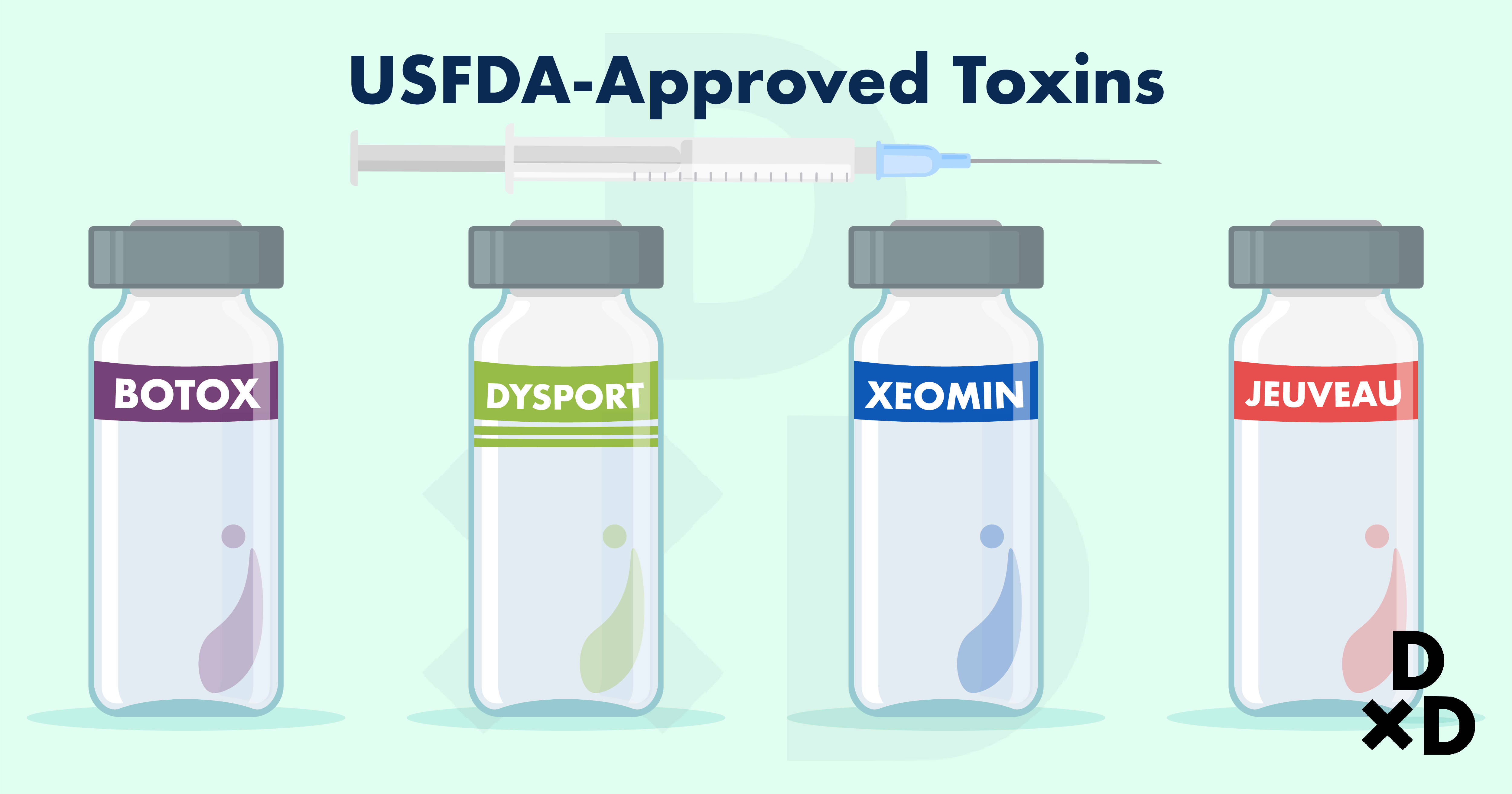
People usually refer to Botox as the treatment name. But do you know it is actually the trade name of the first neurotoxin approved in 2002 by the US Food & Drug Administration (USFDA)? It is known for the reduction of moderate to severe frown lines in between the eyebrows. Which is also referred to as glabellar frown lines. The neurotoxin is produced by an anaerobic bacterium called Clostridium Botulinum. Botox uses a strain called OnabotulinumtoxinA.
Clostridium botulinum was first identified more than 100 years ago. Botulinum toxin, a neurotoxin produced by the Gram-positive bacterium, has been in use since the 1970s. It has now become well-known for cosmetic applications [1].
At the moment, there are three other brands that have been given the go-ahead by the USFDA
- Dysport (abobotulinumtoxinA) in 2009
- Xeomin (incobotulinumtoxinA) in 2011.
- Jeuveau (prabotulinumtoxinA) in 2019 but is only expected to go begin sales late 2019.
There are different types of botulinum toxin products. They can be used not only for cosmetic. From treating eye problems, muscle stiffness and spasms to migraines and overactive bladder issues.
How Botox works
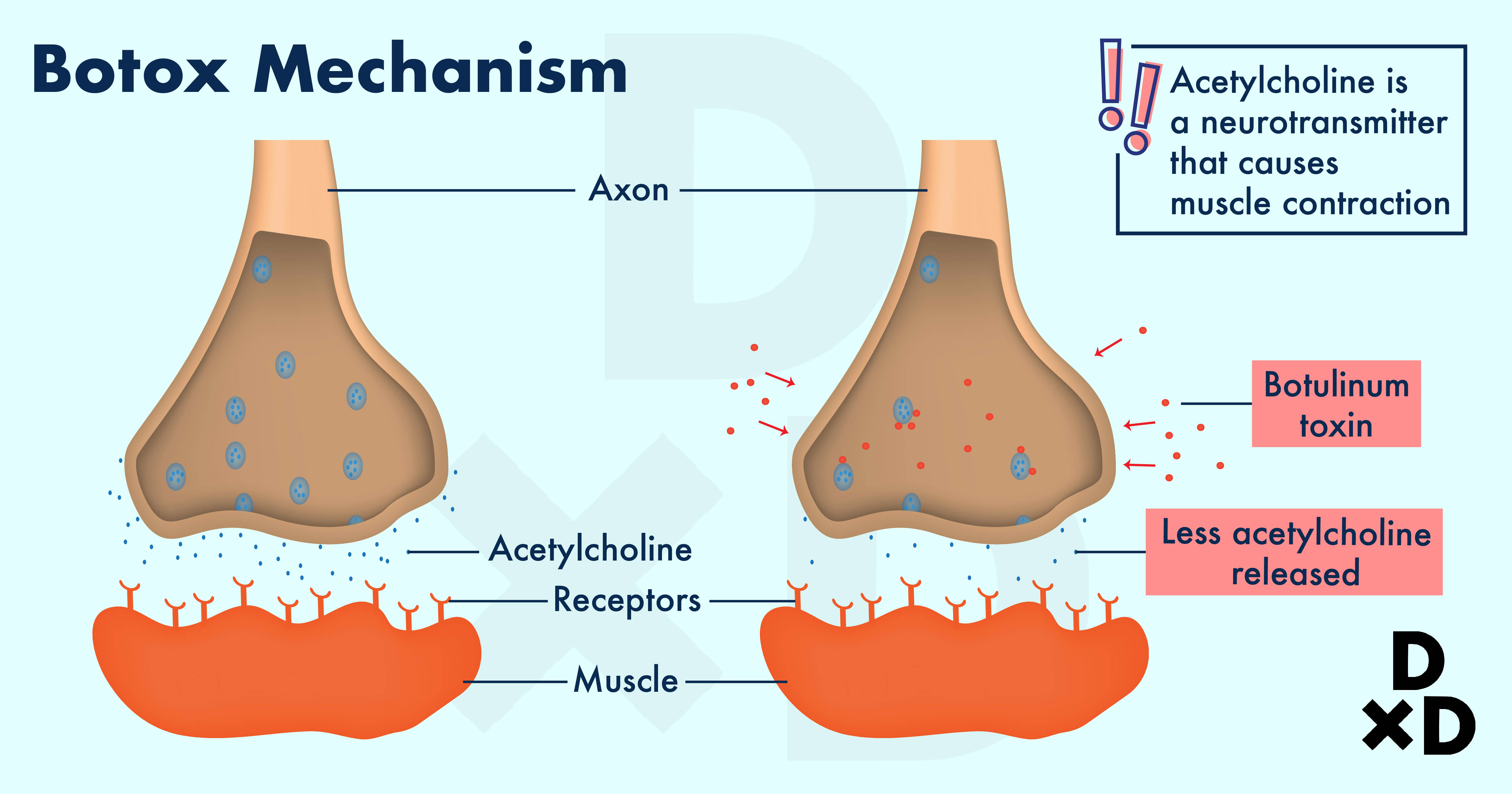
Botox contains a purified form of the toxin that works by blocking the release and action of a compound called acetylcholine [2]. Acetylcholine is a neurotransmitter released by nerve cells and it causes muscles to contract. By blocking the nerve signals from reaching the muscles, or otherwise known as a neurotransmitter blocking effect, the toxins can relax muscles [3].
When injected into facial muscles, the toxin prevents the muscles from receiving signals from the brain to contract. As such, some wrinkles can reduce in appearance, become less visible or even disappear.
Although the toxin is deadly in larger amounts, the amount used in Botox injections are tiny and such treatments can be used safely for years at the expertise and discretion of the practitioner.
The toxin’s effectiveness in blocking neurotransmitters has seen it also being used in treating issues like [4]:
- Strabismus (crossed-eyes)
- Blepharospasm (uncontrollable blinking)
- Muscle stiffness/spasms
- Muscle disorders like cervical dystonia and torticollis
- Headaches in migraine sufferers
- Hyperhidrosis i.e. excessive sweating
Side effects of Botox
Generally, injections with botulinum toxin are generally well-tolerated [5] and side effects are few.
Here, I would like to divide it into two sections to detail injection site reactions and bodily reactions to the toxin.
Injection site reactions
Bodily reactions
- Bruising
- Bleeding
- Pain
- Redness
- Swelling
- Infection (rarely)
Approximately 1-3% of patients may experience a temporary upper lid or brow ptosis following injection to the forehead muscles.
Ptosis refers to a drooping or falling of the upper eyelid. Therefore, patients who have received Botox injections are advised to remain in an upright position for three to four hours as well as avoid manual massaging of the area [6].
- Headache
- Neck or back pain
- Muscle stiffness
- Difficulty in swallowing
- Shortness of breath
- Muscle weakness.
There also exists the risk of allergic reactions with the typical rash and itching.
Common aesthetic indications for Botox
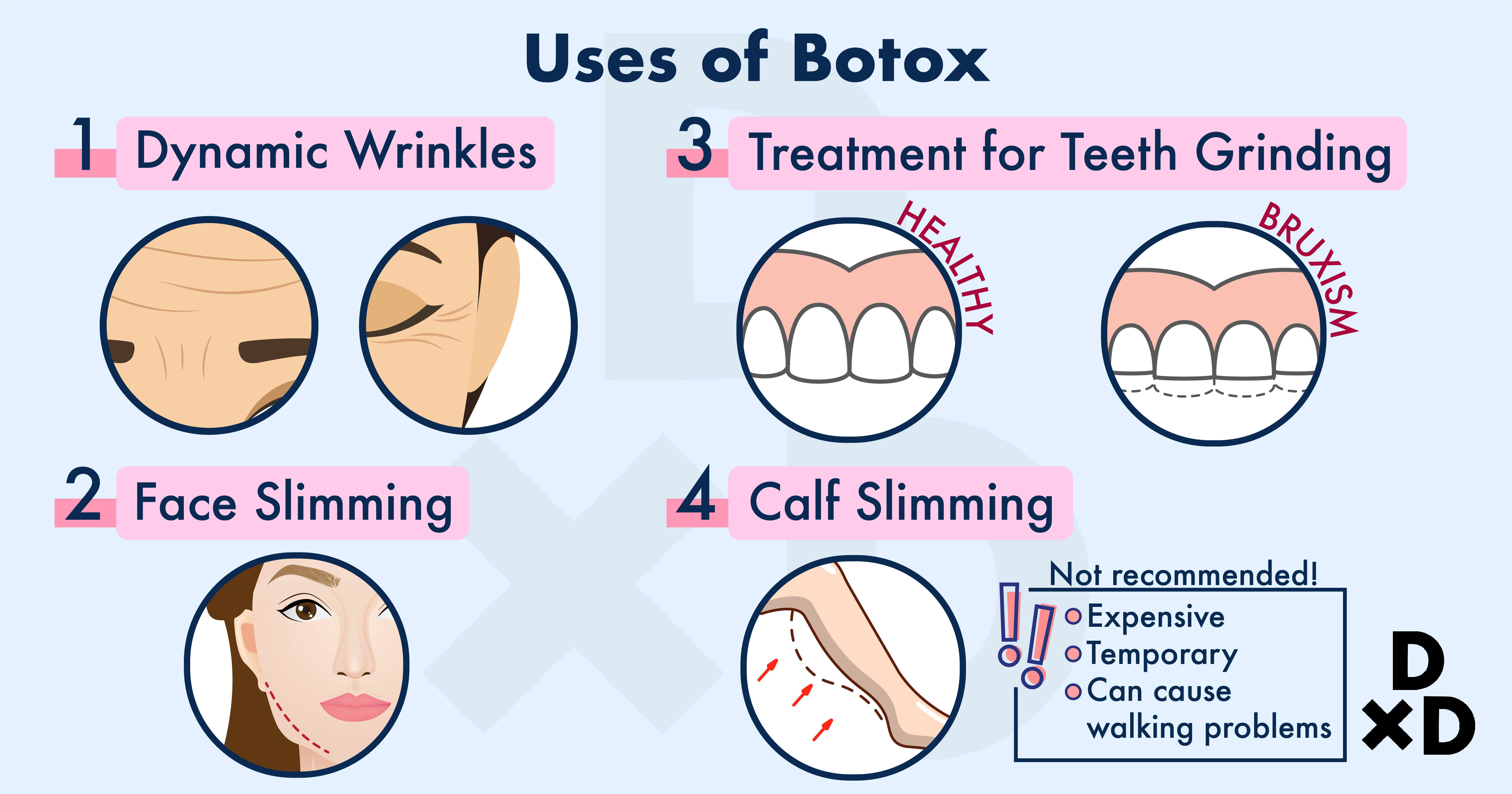
The most common cosmetic indications are the eradication of what is referred to as dynamic wrinkles or wrinkles in motion. In my practice, these would be the glabellar frown lines, forehead horizontal lines and crow’s feet at the lateral angle of the eyes [7].
In addition, Botox is also effective in slimming of the face by reducing the muscle bulk of the masseter or jaw muscles [8]. This can also be a therapeutic indication for those with teeth grinding [9].
Non-facial aesthetic indications for Botox
Another cosmetic indication that is popular in Korea is that of calf muscle slimming. I am not a big fan of this indication as the costs are high with only temporal effects. Also, result in temporary muscle weakness when walking.
Frequently asked questions about Botox
Are Botox treatments painful?
In a majority of cases, a numbing cream is applied to the treatment area before the injection. While patients should expect a stinging sensation during the injection process, the sensation can be more painful in sites where the area is more sensitive. In my experience, I have never had a patient who requested for the procedure to be stopped due to pain.
Do we need repeated Botox treatments?
The effects of Botox treatments typically last an average of 3-6 months. Repeated treatments are needed if you want to maintain the results. However, patients may experience a shorter effect duration when they frequently use their targeted muscles.
Can anyone have Botox?
Contraindications
- Patients suffering from pre-existing motor neuron disease
- Myasthenia gravis
- Neuropathies
- Psychological instability
- History of reaction to toxin or albumin
- Pregnancy
- Lactating females
- Infection at the injection site.
What are dermal fillers?
Dermal fillers, also known as soft tissue fillers, are smooth injectable gels. They contain ingredients that add fullness to areas such as the cheeks, lips and around the mouth that have experienced thinning, depressions, skin folds and volume loss [10].
Since its introduction more than 20 years ago, the uses for dermal fillers have expanded beyond just correcting wrinkles and folds. Currently, we're not only able to use it for cheek, nose and chin augmentation, but also contour and enhance face shapes to produce a facelift-like effect.
The most commonly used type of fillers worldwide as well as in my clinic is the hyaluronic acid fillers. They are classified as temporary fillers [11]. More permanent fillers are not as popular as there is a higher potential for complications to occur. Furthermore, the effects of permanent fillers are not reversible. I will touch on the different types of fillers later.
Related article: https://www.human.com.sg/filler-lift-versus-threadlift
How dermal fillers work
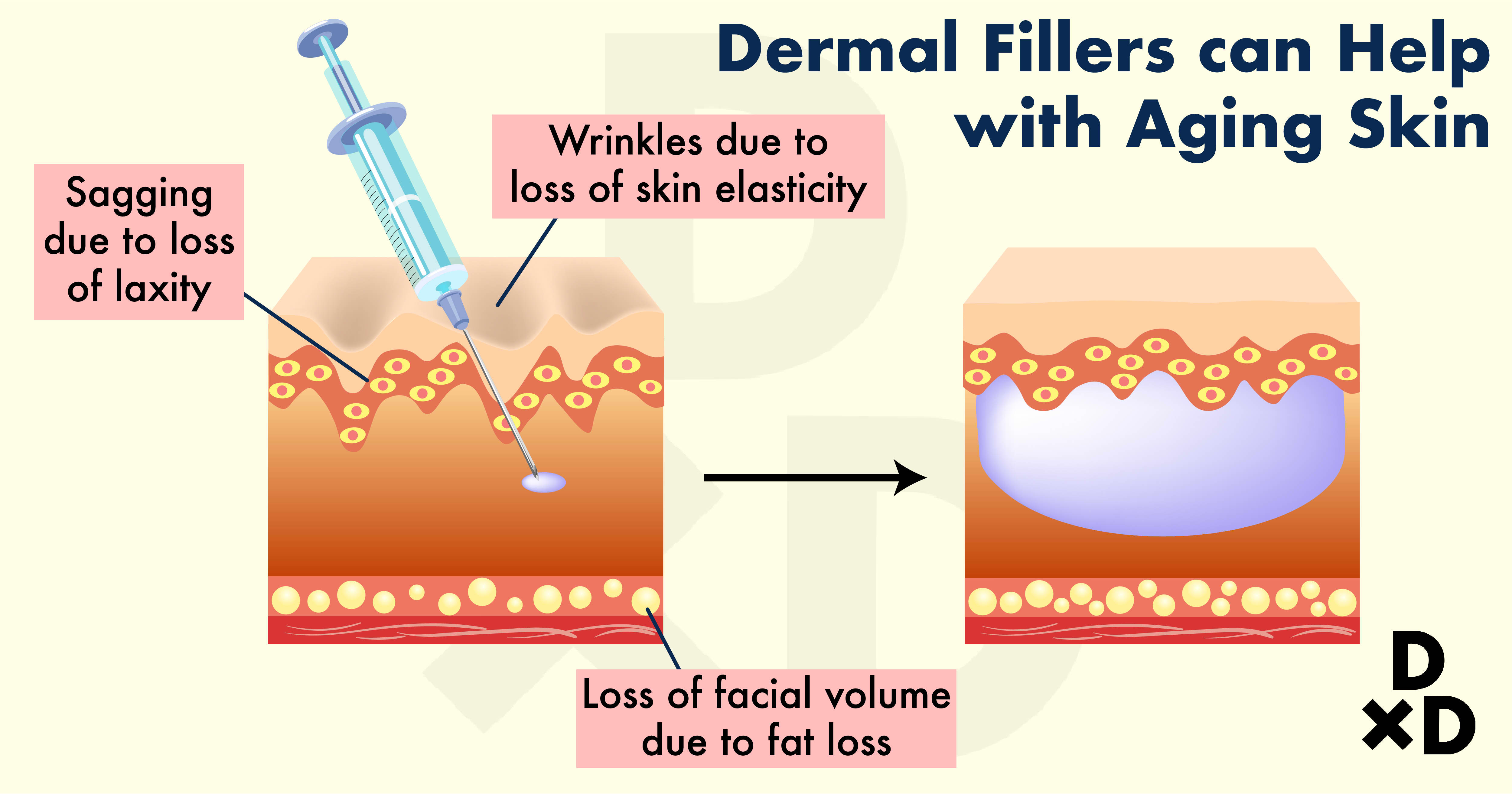
To answer this question, let me first explain how our faces age. I will explain it the way I usually do to my patients.
As we age, we lose three main things that affect how our faces look:
- Loss of skin elasticity and hydro-balance. This contributes to wrinkles, the appearance of deepening nasolabial folds, marionette lines, open pores, and uneven and dry skin texture.
- Loss of facial volume. This is due to fat loss and migration downwards of certain facial fat pads causes sunken under eye, cheeks, temples, and jowling.
- Loss of laxity of retaining ligaments. This causes sagging of lateral corner of the eye, flattening of the cheeks, drooping of the midface, deepening of the nasolabial folds, and drooping of the corner of the mouth, and jowling.
Since different filler gels have different viscoelastic and integration properties, when injected at the right places, they can help you achieve lifting effects appropriate to the part of the face [12].
Types of dermal fillers
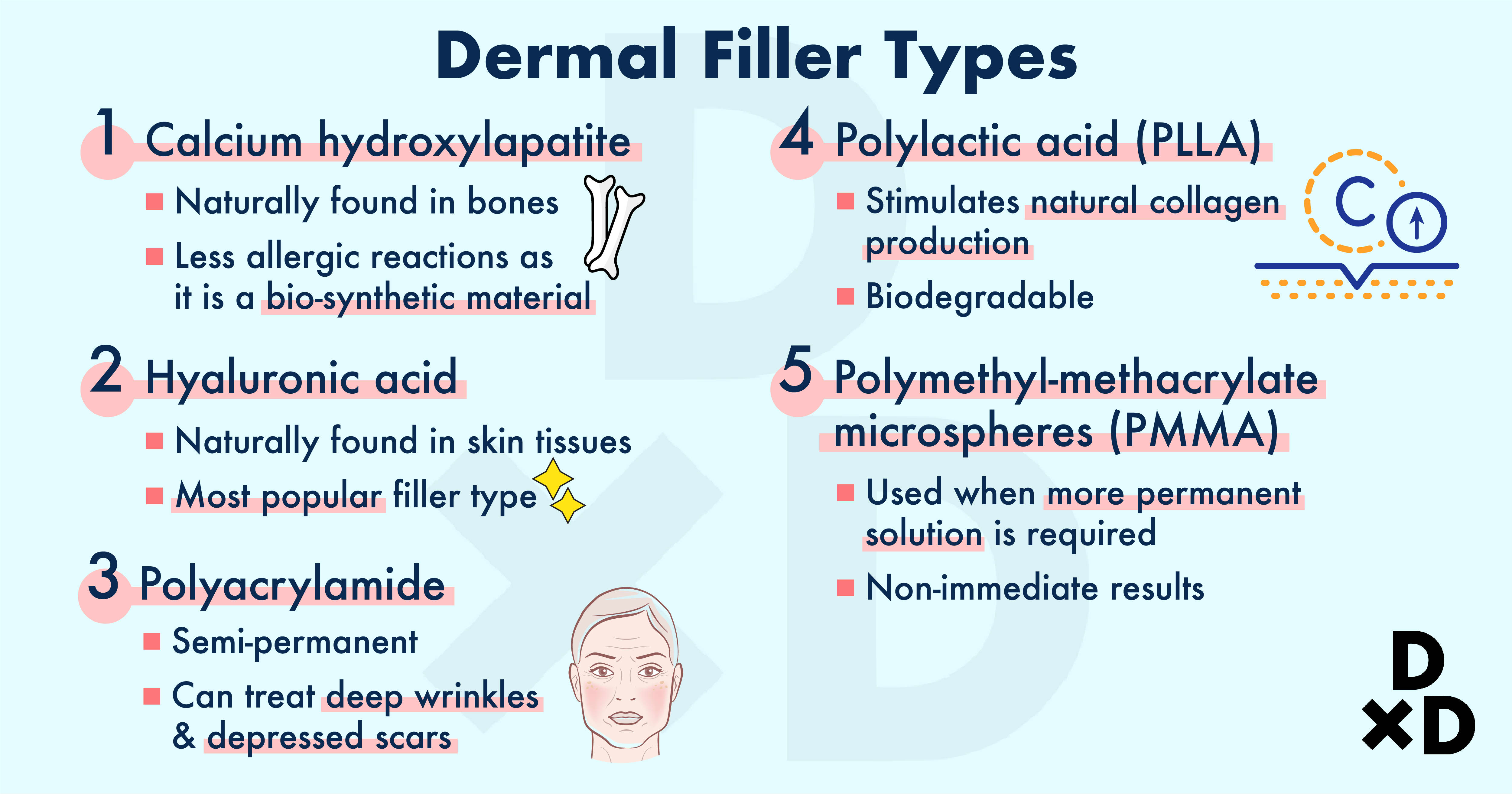
There are different types of dermal fillers available in the market [13]:
Calcium hydroxylapatite
A compound also found in bones, it is often used to treat:
- Moderate to serious creases like marionette lines, frown lines and nasolabial folds
- Enhance facial contours and cheek fullness
- Volumise areas of the face that experience wasting (such as in cases of HIV medications)
Calcium hydroxylapatite possesses a lower risk of allergic reaction as it is biosynthetically produced. This type of dermal filler has a reputation for producing natural-looking results without migration. Side effects from such fillers are rare.
This is used in Radiesse dermal fillers.
Hyaluronic acid
The acid is also naturally present in some bodily fluids and tissues. It is one of the most popular types of dermal filler. It can be injected to dramatically improve:
- Scars from acne, burns and wounds
- Facial depressions
- Crow’s feet
- Smile lines, a.k.a. nasolabial furrows
- Frown lines
- Marionette lines
- Lip border definition
- Smoker’s lines
- Forehead wrinkles
Brands like Juvederm, Restylane, Puragen, Perlane, Prevelle, Hylaform, Elevess, Esthelis and Captique uses hyaluronic acid.
Polyacrylamide
As a semi-permanent dermal filler, it is used by cosmetic surgeons to:
- Treat deep wrinkles like nasolabial folds and depressed scars
- Plump thin lips
- Shape cheeks and jawline, and replace lost facial volume
The compound has little reactions with human tissue and does not interfere with X-rays.
Polyacrylamide is used by Aquamid.
Polylactic acid (PLLA)
PLLA is a synthetic dermal filler that is used to stimulate collagen production. It is non-toxic and biodegradability which is why it has been used as a suture material for decades.
Polylactic acid is used to treat:
- Lines caused by laughing
- Thin lips
- Deep nasolabial folds
Unlike some dermal fillers, PLLA does not produce immediate results. This is because it works by encouraging natural collagen production. Patients are likely to need multiple treatments to attain optimal and longer-lasting results.
Sculptra, one of the more common brands in Singapore, uses PLLA.
Polymethyl-methacrylate microspheres (PMMA)
PMMA is considered as a semi-permanent filler commonly used to address:
- Medium to deep wrinkles
- Furrows and folds, especially nasolabial folds
- Fill pitted scars
- Augment lip volume
PMMA is used when a more permanent solution is desired. However, its downsides include:
- Multiple injections
- Multiple injections
- May be visible under the skin
Bellafill uses PMMA in its products.
Side effects of dermal fillers
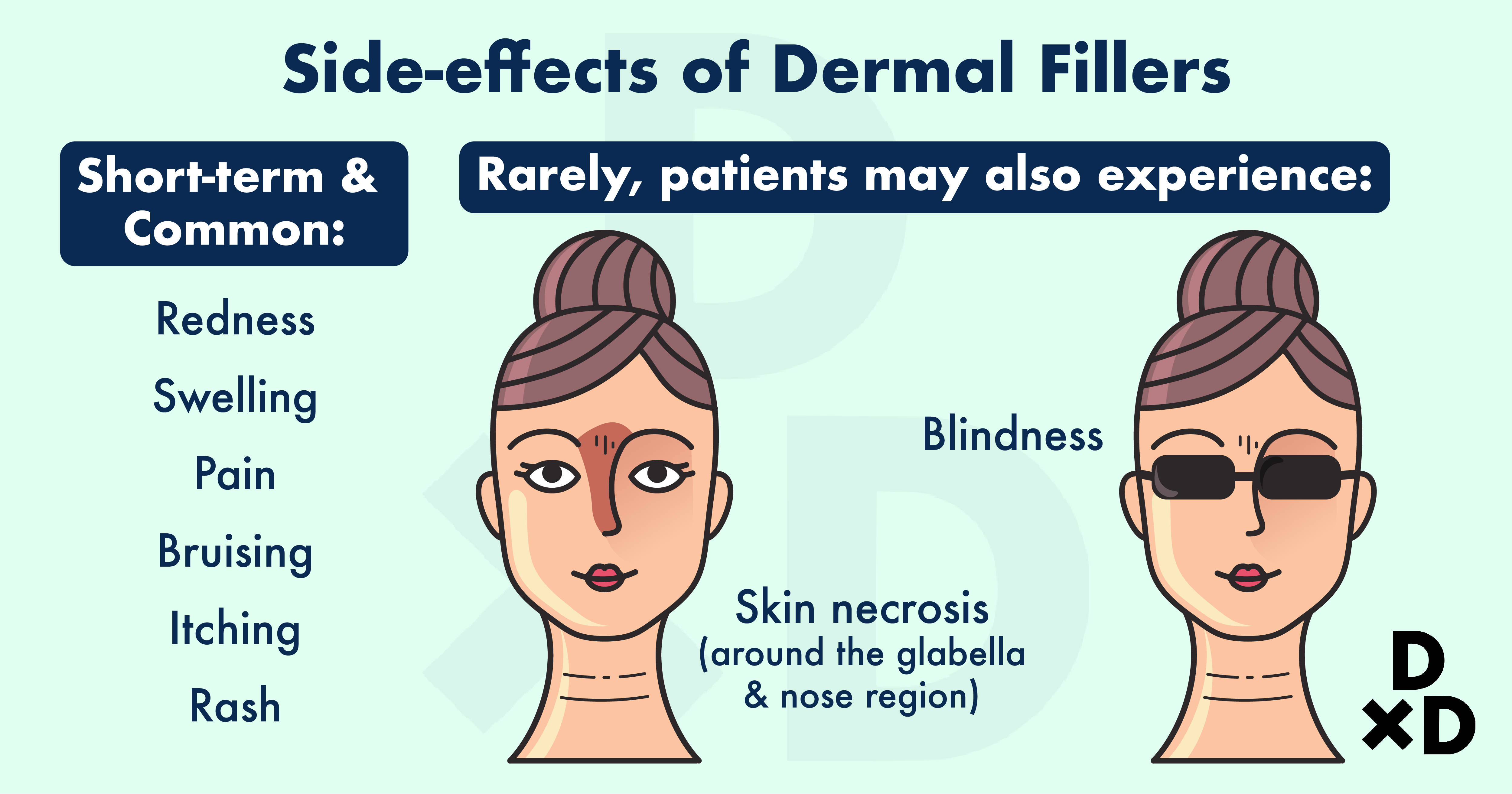
As stated above, dermal fillers are generally safe and are unlikely to trigger serious adverse reactions. However, patients can still experience temporary side effects with no long-term complications:
- Redness
- Swelling
- Pain
- Bruising
- Itching
- Rash
In cases of delayed hypersensitivity or inflammation, oral antibiotics and anti-inflammatory, drugs may be prescribed. Causes of allergies and hypersensitivities could be the results of [14]:
Collagen | Bovine collagen can provoke an immune response in the patient and cause granulomatous reactions. However, the risk is low with an occurrence rate at 1.3%. A short-term course of glucocorticoid therapy is sufficient to arrest the issue.
Hyaluronic acid fillers | After the treatment, granulomatous reactions to foreign bodies can develop over months to years. To resolve such reactions, doctors can use hyaluronidase to break down the filler.
However, there have been reported cases of skin necrosis in common areas like:
Cases of blindness following injections into the nose have also been reported. Most of the times, these are usually due to inexperience or an improper choice of filler product. Nonetheless, it can also occur in the hands of experienced injectors [17].
Can anyone have fillers?
Contraindications for dermal fillers include:
- An active infection near/at the side of the injection
- Known allergy or hypersensitivity to a dermal filler ingredient
- Known allergy to lidocaine, a type of anaesthetic
- Glabellar skin necrosis
The Relationship Between Botox and Fillers
Botox and fillers are similar, and yet very different.
They are both injectable cosmetic procedures and they have the same goal to:
- Enhance your appearance
- Help you get a more youthful look
However, Botox and fillers have different modes of action and cosmetic indications. Each type of filler also works differently. But for the purpose of this article, I am going to only discuss the most common filler: Hyaluronic Acid (HA).
Botox
Fillers
Dose
Used in very small quantities (biologic units).
100 units are diluted in 2.5cc of saline
Ex: Treatment of the glabellar frown lines typically requires only 10-16 units
Pre-filled sterile syringes of 1cc
HA gel comes in different viscosities and different degrees of tissue integration and elasticity
Can be mixed depending on the indication and expected results
Mode of Action
Relaxing muscles, preventing them from contracting
Fill areas that experienced thinning or volume loss to trigger collagen remodelling and to ‘lift’ the skin
Function
Erase dynamic wrinkles (mainly)
Slimming of face to create a more feminine or oval shape
Nose and chin augmentation
Cheek enhancement
Volume fat replacements
Skin textural improvements
Strengthening of ligament anchoring complex of face
Contour and lift the face
Botox and fillers are usually used in different parts of the face. However, certain aesthetic concerns may need a combination of both Botox and fillers. If utilised correctly, the two can also complement each other.
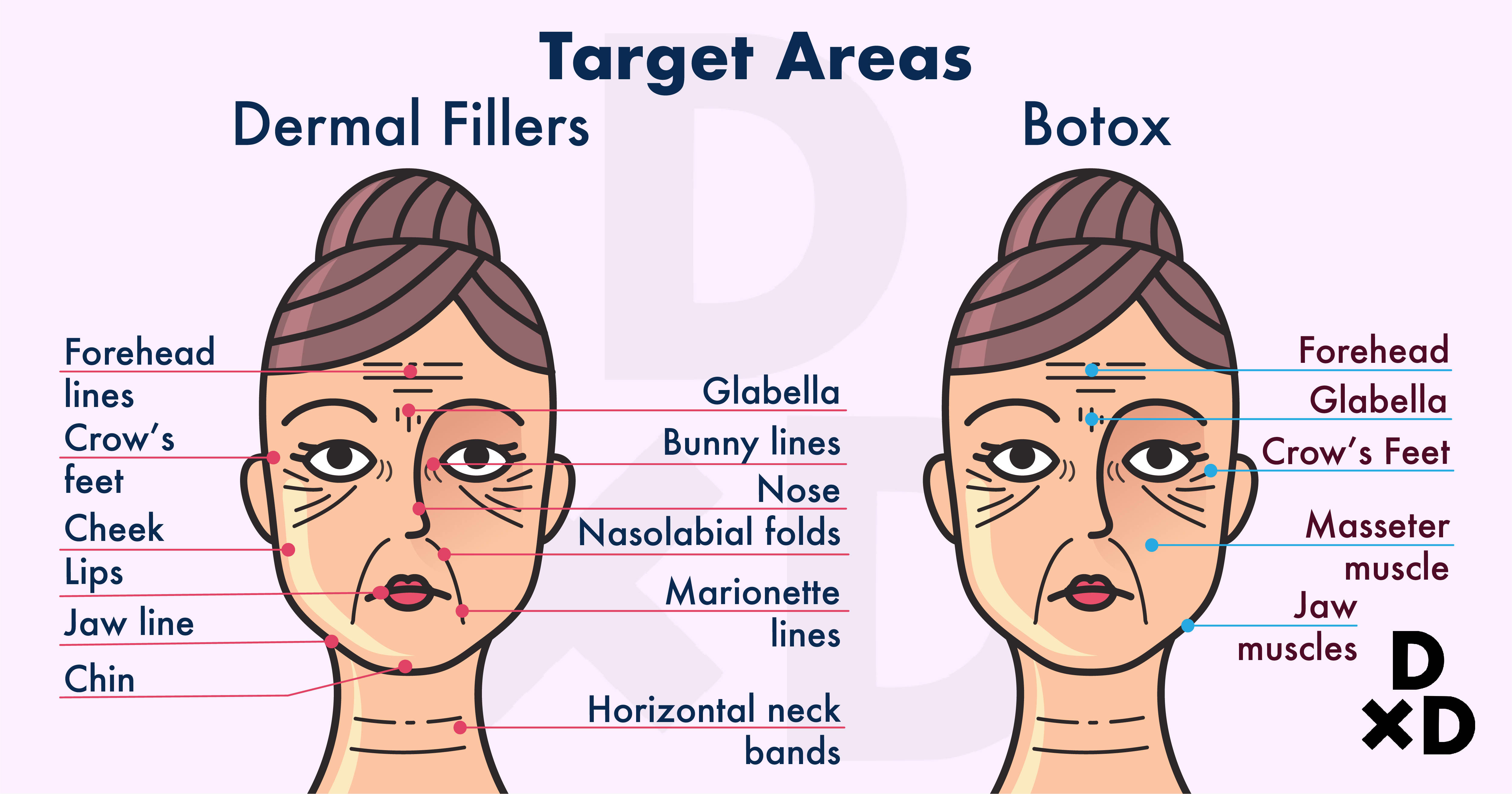
An example of using Botox and dermal filler together is in treating forehead frown lines:
- Toxin injections reduce the appearance of wrinkles
- Dermal fillers smoothen out the area and augment the volume
Are results immediate in both cases?
For Botox, the results usually start to take effect between 3-5 days but it may take up to one week or more for the results to be fully evident.
Fillers, on the other hand, tend to have an immediate result. However, the best results will usually be after the first week. That is after the swelling subsides and enough time is given for the collagen to start remodelling.
Botox or dermal fillers: which one lasts longer?
The impermanent nature of many dermal fillers coupled with the natural and gradual ageing of the skin necessitates repeated treatments to maintain desired effects. Generally, the results of fillers can last on an average of 9-12 months, although in some cases, it can last up to 16 months [18].
Botox on the other hand usually lasts an average of 3-6 months [19].
What are the costs of Botox and dermal fillers?
In Singapore, aesthetic doctors will usually charge for Botox based on the number of biologic units used, although some are known to charge by the area of indication. Generally, the cost would range from $12 to $20 per biologic unit and cost differences between the 3 brands mentioned above do not differ much.
With regards to fillers, most doctors here will charge based on the total number of syringes used with each syringe typically 1 cc each. The cost can vary usually from $600 to $1,200 per syringe, depends on the brand used, as well as the doctor's charges.
Also Read: The Ultimate Guide to Seeing an Aesthetic Doctor in Singapore (2020)
Conclusion
Botox and fillers are useful tools for anyone looking to have a more youthful look. They can complement each other really well to enhance your facial features.
To know which one is best for you, it is best to consult an experienced doctor! They can help you plan a treatment specific to your expectations. Get to know exactly why you need the treatment and their side-effects before committing to anything.
Good luck!












